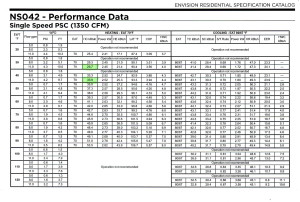More is always better!
“Less is a disaster” – Stan Marco
It seems that in geo design everyone is always trying to design the smallest loop possible to save money. Are they saving money? The answer is a clear NO.
My son the physicist says that I should quantify things instead of ranting, so here goes…
On the accompanying chart of a typical WaterFurnace unit, it shows 30degF and 40degF EWT, (entering water temp) and the accompanying heat output, 29,700 Btu/hr and 33,900 respectively. The longer loop length gives you a higher EWT.
At a typical 2500 hrs/year of run time, we get a difference of 4,200 Btu/hr x 2500 hrs = 10,500,000 Btu/year more heat. That was 10.5 million Btu’s! This translates to a reduced runtime of 10.5mBtu/yr / 33,900Btu/hr = 310 run hours/yr for the same load. Nice!

310 saved runs hours/year cost 2.52kW (from the chart) x $0.15 (your local electric rate will vary) x 310 = $117.20 per year in savings plus a proportional increase in heat pump lifespan, approx 12.4%. It will actually be more as the heat pump will be running in a sweeter range, but I can’t quantify that one.
For a heat pump that costs $12,000 and lasts 20 years, (the loop lasts 50+) a 12.4% increase in lifespan is worth $1448, or $74.40 per year.
Combining the energy and heat pump savings you get $117.2 + $74.4 = $191.60 per year saved. Over a 20 year lifespan, this equates to a savings of $3832!
That said, one normally discounts future savings at a rate equal to the interest rate you’d earn if you were investing money in say, federal bonds. So, this savings should be worth less than $3832 in present day dollars. However, we can’t forget the price of electricity is increasing faster than federal bonds which will make the $117 yearly energy savings increase. That is, Year n savings is = $117.2 * (1+energy increase)^n/(1+discount rate)^n + $74.4/(1+discount rate)^n
Including all of these factors, and taking an electricity increase rate of 8%/year and a discount rate of 4%/year, we find a savings of $4,578! How much extra it will cost to make your loop 10deg EWT better is very site specific, but certainly less than the $4578 in savings.
And then, when the heat pump needs replacement, you’ll undoubtedly get the then more advanced model which can extract more heat. Uh-oh, now your budget loop is too small…the performance of your new more efficient heat pump is degraded right from its start.

